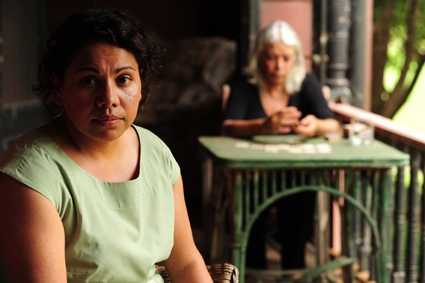Speaking of ghosts
Katerina Sakkas: Warwick Thornton, The Darkside

Deborah Mailman, Marcia Langton, The Darkside
photo Tony Mott
Deborah Mailman, Marcia Langton, The Darkside
Drawing upon primal fears of darkness and the mysteries of death, the ghost story is perhaps the most relatable of tales. With this feature-length addition to a venerable ghost anthology tradition which encompasses collections of stories from different cultures, eras and individual writers, Samson and Delilah (2009) writer-director Warwick Thornton seeks to explore an Indigenous experience of the ‘other side.’
After calling via traditional and social media channels for first-hand accounts of ghostly encounters, Thornton and producer Kath Shelper narrowed an initial 150-odd submissions down to a dozen. Using Thornton’s interviews with these 12 storytellers as core material for the screenplay, the resulting film is part-genre, part-oral history project. It is full of a promise that doesn’t quite materialise.
Except in a couple of cases where the storyteller doesn’t appear onscreen, each story is presented essentially in monologue by an Australian actor, with Bryan Brown, Deborah Mailman, Claudia Karvan, Aaron Pedersen, Jack Charles and Sacha Horler among the prominent names featured. Thornton’s preferred approach is to maintain a largely static shot of the teller in his/her environment—an environment that sometimes reflects the narrative (river and coastal stories are told by Brown and Horler near water; Shari Sebbens’ account of a family vigil for a dying infant is told in a hospital). In some instances, however, more lateral or abstract images are superimposed over the teller’s voice, most notably during Sharon Cole’s eerie roadside tale, accompanied by artist Ben Quilty working close-up on one of his characteristic impasto landscapes. Ultimately, the painting resolves at a distance into an image which resonates with the story’s conclusion. It’s a texturally interesting approach, though the footage tends to compete with the words.
It’s no coincidence that the more concise stories, as well as those whose visuals accentuate rather than nullify the verbal content, are among the more engaging in the collection. Filmmaker Romaine Moreton speaks of a troubled residency at the National Film and Sound Archive, formerly the Australian Institute of Anatomy, over a pastiche of foreboding interiors, historical ethnographic footage and the piercing light of a film projector—images which lend a clinically cruel edge to her account of the unsettled dead. Some narrators command more attention than others, with skilled raconteur Jack Charles at the fore here.
The Darkside’s main problem is verbosity. Thornton’s commitment to exactly replicating these interviews, intrinsically interesting as they are, is at odds with the overwhelmingly visual nature of cinema. As tales meander and fall into repetition, the viewer’s attention wanders. The director’s recent forays into video installation with Stranded, 2011 (commissioned by the Adelaide Film Festival; RT102) and Mother Courage, 2012 (commissioned for Documenta13; RT113) seem to have influenced The Darkside’s deliberate pace and use of imperceptibly changing imagery. It’s an approach that’s more suited to the fluid dynamic of a gallery than the captive situation of the movie theatre, where attention needs to be seized and maintained. Thornton might have been trying to avoid horror movie clichés, but attention to the way the best genre cinema manages to grip its audience viscerally would have given these stories a far greater chance to shine.
The Darkside, director, cinematographer Warwick Thornton, editor Roland Gallois, sound designer Liam Egan, producer Kath Shelper; Australian distributor Transmission Films
RealTime issue #118 Dec-Jan 2013 pg. 26






